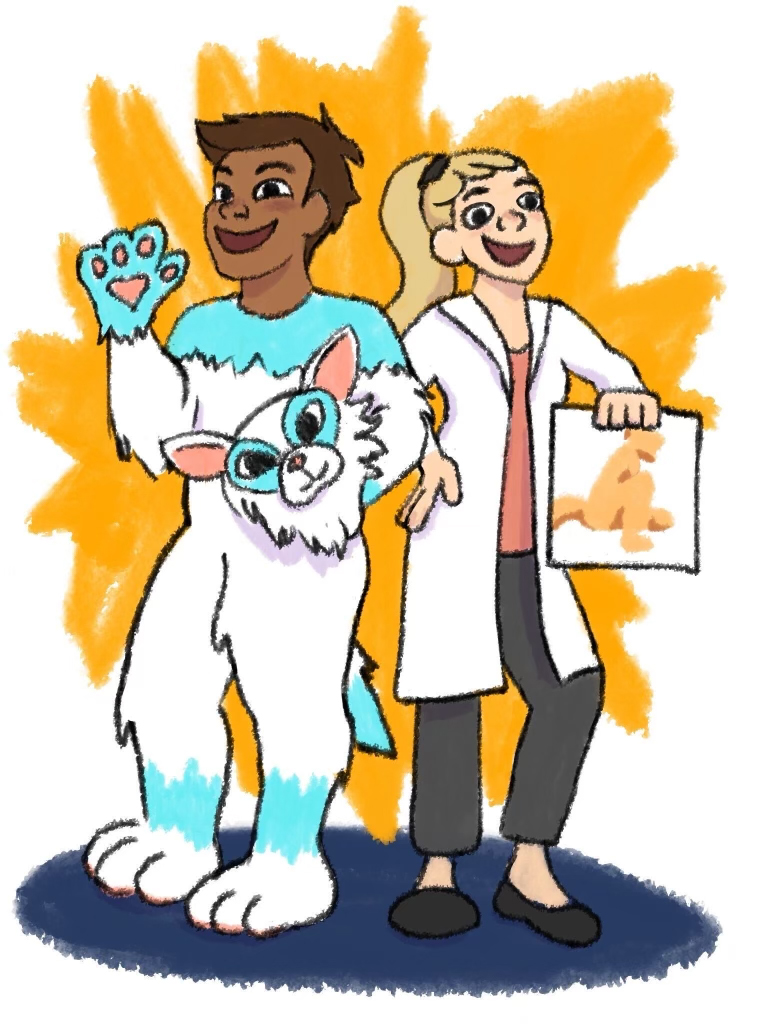Forum
Everything you know about furries is wrong
 Illustration by Adel Cynolter
Illustration by Adel Cynolter Sitting in the Center for Diversity and Inclusion, Washington University freshman Casper was discussing furries’ role in building the internet when a stranger interrupted: “I don’t buy it. Furries?” they chuckled. “What?”
Casper chose to be interviewed in the Center for Diversity and Inclusion because of negative stigmas and safety risks often directed at their community. Casper is a furry. There are no requirements for identifying as a furry, as he explained, “The one thing you have to do to be a furry is say you are a furry.”
The interviews conducted for this article feature the voices of three anonymous WashU students who are members of the furry community: first-year student “Casper,” junior student “Blu,” and graduate student “Cour.”
According to the National Library of Medicine, furries are people who are exceptionally interested in anthropomorphic or cartoon animals. They frequently create fursonas, or manifestations of themselves as those animals. The community bonds over these depictions, art, and each others’ fursonas. Some practice fursuiting — wearing costumes that resemble human-like creatures.
Furries seem to be a touchy subject, but why? On a campus where inclusion is central to our university’s goals and where there’s “something for everyone,” how did furries get left behind? The interviewees’ perspectives challenge misconceptions about furries, such as the furry identity being central to their lives and that all partake in sexual activity relative to the community. Members outside the community must improve their attitudes and predispositions regarding furries.
Truly, the furry community varies in its member’s involvement. Similar to fandoms like anime or cosplay, members are self-labeled and choose their own levels of participation. While Casper has possessed multiple fursuits over the years, Cour owns a simple sketch of his fursona. With varying extents of membership, furries are not tied down to a single community or identity.
Outside of the fandom, furries are artists, programmers, writers, and researchers. Casper draws the overlap between furries and sci-fi, contextualizing many furries’ fields of study in Computer Science with their accomplishments in building everything from online chat rooms to the Moderna Vaccine and their part in building the Internet. Many furries are artists, including Casper himself, who has built a profitable side hustle selling fursuits. Further, Blu is a Data Science major and Cour is in graduate school for astrophysics interested in pursuing academia. Cour acknowledged the future for furries in art, as he knows a furry who works as an animator for DreamWorks. While creating fursuits, art, and videos can be a profitable hobby in itself, furries’ creative anthropomorphic design skills are valuable assets to society’s markets in film, costumes, and entertainment.
Just as the furry community is not rooted solely in fursuits, it is neither dependent on sexual activity. Because fursuits are expensive, awkward, and sweaty, for many, getting frisky in fur seems entirely undesirable. Casper laughingly explained, “Yeah, that’s a huge risk for heatstroke. Genuinely, that concerns me.”
Of course, there are corners of the community that contain adult themes; however, this is no different from any other fandom. Cour, Casper, and Blu all stated that they do not partake in furry-related sexual activity.
It is no secret that stigmas around the community compel members to gather in private. The furry community has struggled to control its public image, especially as right-wing politicians spew false reports of furries asking schools to place litter boxes in their bathrooms to accommodate students who identify as animals. This sensationalist misinformation has led to backlash and misunderstanding directed toward the furry community, ranging from stigmatizing jokes and chat room raids to physical assaults. In fact, Casper mentioned that the fandom has had to develop physical assault response protocols due to increasing safety risks, such as immediately taking off their headpiece if faced with aggression.
At WashU, there are over 460 student organizations to build community and establish social connections. While the furry fandom has existed since the early-to-mid-1980s, it flourished with increasingly virtual connections over the COVID-19 pandemic. Furries on campus mostly stick to online group chats on Discord, Twitter, Furaffinity.net, or informal meetups and conventions. This discretion is due to the risk of backlash or violence from non-members in public.
To combat these stigmas, local efforts like the Gateway FurMeet (a furry convention in St. Louis) and the convention panel, “How to Survive College as a Furry,” should be celebrated as these local, public transportation-friendly meetups support a long underrepresented community.
With the help of furries facilitating local meetups and continuing to have brave attitudes to defend the community from misconceptions, the furry fandom can be a thriving safe place for many members. Indeed, a large percentage of the fandom’s patrons are neurodivergent or identify as LGBTQ+.
Regarding contact information, furries who go to WashU can message community leader @crapsketches on Telegram about more fur-meets throughout the semester. For its members, the furry community provides refuge, support, and connections, and with increasing member turnout, their club is considering becoming WashU-official.
As Casper said, “Furries are normal people. There are furries at WashU, and they are human beings just like anyone else.” Even amid backlash, furries remain positive, support an inclusive environment where people can be themselves, respond compassionately to ignorance, and showcase themselves as valuable people. These students are creative, accomplished, and worthy of being treated like anyone else.
